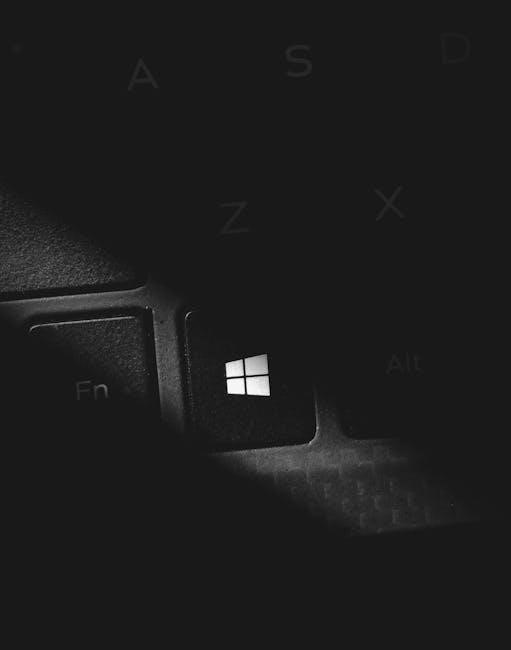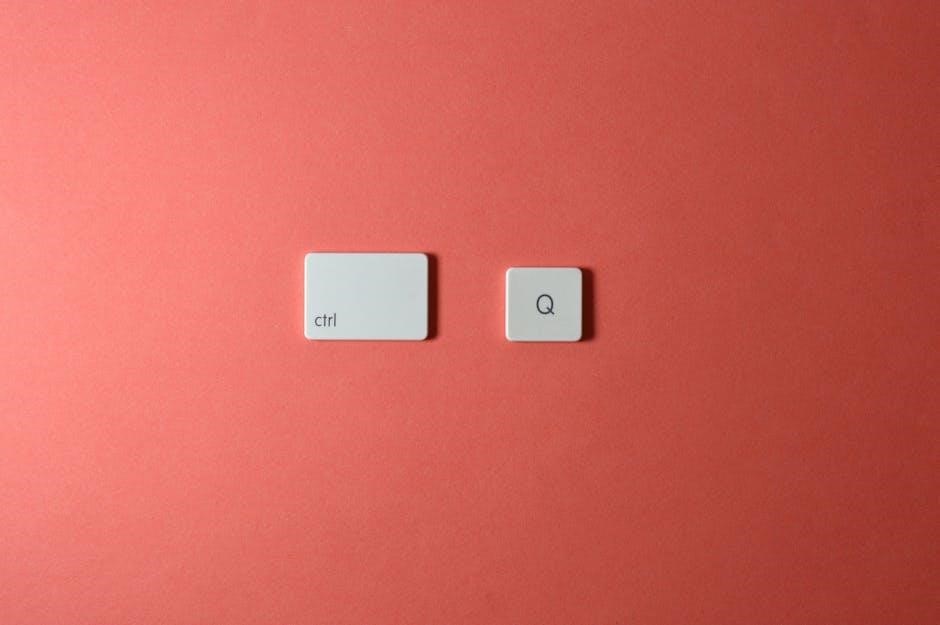fcpx shortcut keys pdf
Mastering FCPX shortcut keys can significantly enhance your editing efficiency. This guide provides a comprehensive overview of essential and advanced shortcuts, helping you streamline your workflow. Whether you’re a beginner or a seasoned pro, these shortcuts will boost your productivity and creativity in Final Cut Pro X.

Essential FCPX Shortcut Keys
Essential FCPX shortcuts include J, K, L for playback control, Cmd+Z for undo, and Cmd+D for duplicate. These fundamental shortcuts streamline navigation, editing, and playback, enhancing your overall editing efficiency and workflow in Final Cut Pro X.
Navigation Shortcuts
Navigation shortcuts in Final Cut Pro X are designed to help you move quickly and efficiently through your project. One of the most essential shortcuts is Cmd + Plus (+) and Cmd + Minus (-), which allow you to zoom in and out of the timeline. This is particularly useful for precise editing or getting a broader view of your project. Another key shortcut is Shift + Z, which fits the current clip or project to the Viewer, ensuring you can see your work clearly.
The Hand tool, accessed with the H key, enables you to pan around the timeline, making it easy to navigate through complex projects. Additionally, Cmd + Home takes you to the beginning of the timeline, while Cmd + End jumps to the end, saving time when reviewing your work. For frame-accurate navigation, use Left Arrow and Right Arrow to move one frame at a time, or Shift + Left/Right Arrow to move 10 frames. These shortcuts streamline your workflow, allowing you to focus on creativity rather than navigation.
Mastering these navigation shortcuts will significantly improve your editing speed and precision in Final Cut Pro X. They are foundational to any editor’s toolkit and are essential for both beginners and professionals alike.
Editing Shortcuts
Editing shortcuts in Final Cut Pro X are designed to streamline your workflow, allowing you to make precise cuts and adjustments quickly. One of the most frequently used shortcuts is B, which activates the Blade tool for splitting clips directly in the timeline. Another essential shortcut is RR, which enables Ripple edits, letting you adjust the length of a clip while maintaining the project’s overall duration; Pressing RR again disables the Ripple tool.
The SS shortcut activates the Slip tool, which allows you to adjust a clip’s position within its bounds without affecting the timeline’s length. Conversely, the SD shortcut enables the Slide tool, letting you move a clip while maintaining its duration. For previewing clips, use the Spacebar to play the selected clip or the entire project. The V key selects the Volume tool, making it easy to adjust audio levels directly in the timeline. Additionally, Cmd + A selects all clips, while Cmd + D deselects them, helping you manage selections efficiently. Finally, Cmd + Z and Cmd + Shift + Z handle Undo and Redo actions, ensuring you can experiment without fear of losing work.
These editing shortcuts are indispensable for any FCPX user, enabling faster and more precise edits while maintaining focus on the creative process. They are the foundation of an efficient post-production workflow.
Playback Shortcuts
Playback shortcuts in Final Cut Pro X are vital for previewing and reviewing your edits efficiently. The Spacebar is the most basic yet essential shortcut, used to play and pause playback in the timeline or preview window. For more precise control, use the J key to rewind, L to advance forward, and K to pause playback. Pressing L multiple times increases the playback speed, while pressing J multiple times increases the rewind speed.

To quickly navigate through your project, use the Shift + Spacebar to play the timeline from the beginning. The Option + Spacebar plays the timeline in full screen, providing an immersive preview experience. Another handy shortcut is Cmd + L, which toggles looping playback on and off, allowing you to continuously review a specific section.
For skimming through clips, enable skimming by pressing S, which lets you preview clips without changing the playhead position. To disable skimming, press S again. Additionally, the Shift + S shortcut toggles snapping on and off, helping you align clips precisely. These playback shortcuts ensure you can review and refine your edits with maximum efficiency and accuracy.
Mastering these playback shortcuts enhances your ability to navigate and preview your project seamlessly, making the editing process smoother and more intuitive.

Advanced FCPX Shortcut Keys
Cmd + Z and Cmd + Shift + Z are essential for undoing and redoing actions. Use Option + drag to duplicate clips and Shift + drag to slip clips. Cmd + Opt + T toggles the toolbar, and Option + click enables precise adjustments. Master these shortcuts to streamline your advanced editing workflow efficiently for maximum efficiency.
Trimming Shortcuts
Mastering trimming shortcuts in Final Cut Pro X (FCPX) is essential for precise video editing. Use Cmd + Option + [ and Cmd + Option + ] to navigate between edit points. The blade tool (B) helps split clips, while Shift + R opens the Range Selection tool for selecting specific portions. For fine-tuning, Option + drag adjusts the clip edges, and Shift + drag slips the clip within the timeline. Cmd + / adds markers for easy reference; Use Option + Up/Down Arrow to adjust the clip length and Shift + Up/Down Arrow to slip-sync. These shortcuts streamline trimming, enabling efficient and accurate edits, saving time, and enhancing workflow productivity for editors seeking precision in their projects. Learning these will help you work faster and maintain control over your edits.
Audio Editing Shortcuts
Mastering audio editing shortcuts in Final Cut Pro X (FCPX) is crucial for refining your sound design and ensuring professional-quality audio. To add an audio clip, use A or Shift + A for an audio-only edit. Use V to paste audio, and Option + V to paste audio at the playhead position. For syncing audio, press Shift + S to enable syncing. Adjust audio levels quickly with Option + Up/Down Arrow to fine-tune.
Ctrl + Option + A detaches audio from a clip, while Shift + A disables audio. Use Cmd + Option + F to fade audio in or out. For precise adjustments, Shift + R opens the Range Selection tool, and Option + drag adjusts the audio level. Cmd + / adds markers for syncing audio with video. These shortcuts streamline audio editing, allowing you to work efficiently and maintain high-quality sound in your projects. By mastering these, you can enhance your workflow and deliver polished results.
Color Grading Shortcuts
Mastering color grading shortcuts in Final Cut Pro X (FCPX) enhances your ability to create visually stunning projects. To open the Color Board, press Cmd + 6, while Option + Cmd + 6 resets all color adjustments. Use Shift + Cmd + 6 to compare before and after views, helping you gauge your progress.
For precise adjustments, Option + drag fine-tunes parameters like exposure or color wheels. Shift + Cmd + P applies a color preset, saving time. Toggling the Color Board with Cmd + / allows quick access.
Additionally, Shift + Cmd + M enables the Precision Color Mask, and Option + Cmd + M toggles the Color Mask. These shortcuts streamline color grading, allowing you to achieve professional results efficiently. By memorizing these, you can enhance your workflow and deliver visually impressive projects.
Multi-Camera Editing Shortcuts
Mastering multi-camera editing shortcuts in Final Cut Pro X (FCPX) streamlines your workflow when working with multiple camera angles. To open the Angle Editor, press Shift + Cmd + E, while Option + Shift + Cmd + E closes it. Use Shift + Cmd + to switch between camera angles in the Angle Editor.
For quick angle switching during playback, use 1-9 on the keyboard to cycle through up to nine camera angles. To enable or disable a camera angle, press Shift + Cmd + V. Additionally, Shift + Cmd + Option + / toggles the multi-camera editing viewing mode.
These shortcuts allow you to efficiently manage and switch between multiple camera angles, ensuring a smoother editing process. By leveraging these commands, you can focus on creating dynamic and engaging multi-camera sequences without unnecessary delays.

Customizing FCPX Shortcuts
Final Cut Pro X allows users to tailor their editing experience by customizing shortcuts, making workflows more efficient and personalized. To access the shortcut customization interface, navigate to Final Cut Pro > Preferences > Keyboard. This opens a comprehensive keyboard layout where you can modify existing shortcuts or create new ones.
In the Keyboard Preferences window, you can hover over any command to see its current shortcut. Pressing Shift + Cmd + K toggles the keyboard customization mode, enabling you to assign new shortcuts. For instance, you can reassign a rarely used shortcut to a frequently used function like Shift + Cmd + C for copying attributes.
Additionally, FCPX supports saving multiple custom shortcut sets. Use Shift + Cmd + Option + S to save your custom shortcuts and Shift + Cmd + Option + L to load them. This feature is ideal for collaboration or switching between different editing styles. By customizing shortcuts, editors can enhance productivity and maintain focus on their creative process.
It’s important to regularly review and refine your custom shortcuts to ensure they remain intuitive and relevant to your workflow. This level of customization is a testament to FCPX’s flexibility and adaptability, making it a powerful tool for professional editors.

Creating a Shortcut Keys PDF Guide
Creating a shortcut keys PDF guide for Final Cut Pro X is an excellent way to have all essential shortcuts at your fingertips. To generate such a guide, you can use the built-in keyboard shortcuts list within FCPX. Go to Help > Keyboard Shortcuts PDF to automatically generate a comprehensive PDF document containing all default shortcuts.
If you prefer a customized guide, you can create one manually using a word processor or design tool. Organize shortcuts by category, such as Navigation, Editing, and Playback, for easier reference. Include descriptions and examples to enhance clarity. Additionally, you can export custom shortcut sets from FCPX preferences and include them in your guide.

Once your guide is ready, save it as a PDF and consider printing it for quick access. This guide is particularly useful for new editors learning the ropes or professionals seeking to streamline their workflow. By creating a shortcut keys PDF, you ensure that all essential commands are readily accessible, helping you work more efficiently in FCPX.

Top Resources for FCPX Shortcuts
Mastering Final Cut Pro X shortcuts can significantly enhance your editing efficiency, and there are several top resources available to help you learn and reference these shortcuts. One of the most reliable sources is the official Apple Final Cut Pro X documentation, which provides a comprehensive list of keyboard shortcuts in a downloadable PDF format. Additionally, third-party websites like FCPCourses and FCPX Free Resources offer detailed cheat sheets and guides tailored for both beginners and advanced editors.
Another excellent resource is the Final Cut Pro X Shortcut Guide available on the Apple Support website. This guide is regularly updated to reflect new features and shortcuts added to the software. For visual learners, YouTube channels like PremiumBeat and FCP X Tips provide video tutorials and shortcut roundups that are easy to follow. Furthermore, community forums such as the Final Cut Pro X Subreddit and Apple Support Communities are great places to ask questions and share shortcut tips with other editors.
Lastly, consider downloading FCPX shortcut cheat sheets from trusted sources like Toolfarm or Motion Array. These resources are designed to help you maximize your productivity and streamline your workflow in Final Cut Pro X.

Best Practices for Learning Shortcuts
Learning Final Cut Pro X shortcuts requires a strategic approach to maximize efficiency and minimize frustration. Start by focusing on the most frequently used shortcuts, such as basic navigation and editing commands, before moving on to more advanced ones. Practice these shortcuts regularly, as repetition is key to developing muscle memory. Consider using a FCPX shortcut keys PDF as a reference guide to keep essential commands at your fingertips.
Break your learning process into manageable chunks. For example, dedicate a week to mastering navigation shortcuts before progressing to editing or playback commands. Use the built-in Keyboard Shortcuts window in Final Cut Pro X to explore and customize shortcuts. This tool allows you to view, print, or even modify shortcuts to suit your workflow.
Another effective strategy is to focus on shortcuts that save the most time in your specific editing style. For instance, if you work with multi-camera footage, prioritize learning multi-camera editing shortcuts. Additionally, incorporate shortcut learning into your daily editing routine rather than trying to memorize them all at once. Consistency is key to long-term retention and improved efficiency.
Mastering Final Cut Pro X shortcut keys is a powerful way to enhance your editing efficiency and creativity. By familiarizing yourself with essential and advanced shortcuts, you can streamline your workflow, reduce the time spent on repetitive tasks, and focus more on the artistic aspects of your projects. The ability to customize shortcuts further tailors the software to your specific needs, making it an indispensable skill for any editor.
A well-organized FCPX shortcut keys PDF can serve as an invaluable reference, providing quick access to the commands you use most. Whether you’re a beginner or an experienced editor, consistent practice and adaptation to new shortcuts will keep your skills sharp and your workflow optimized. Remember, shortcuts are not just about speed; they’re about maintaining focus on the storytelling and visual elements that bring your vision to life.
Investing time in learning and customizing FCPX shortcuts is a worthwhile investment in your professional growth. With dedication and practice, you’ll unlock the full potential of Final Cut Pro X and elevate your editing to new heights.

Keyboard Layouts and Compatibility
Keyboard layouts and compatibility play a key role in optimizing FCPX shortcuts. Ensure your keyboard matches your system requirements, as Mac and Windows layouts differ. Customizing your keyboard layout can significantly enhance productivity and streamline your editing workflow effectively.
Windows vs. Mac Keyboard Differences
Understanding the differences between Windows and Mac keyboards is crucial for mastering FCPX shortcuts. Mac keyboards feature Command (⌘) and Option (⌥) keys, which are central to FCPX functionality, while Windows keyboards use Ctrl and Alt. These variations require adjustments in shortcut usage.
- Windows keyboards include additional keys like the Windows key, which isn’t present on Mac keyboards. These extra keys can sometimes cause confusion for editors transitioning between systems.
- FCPX is optimized for Mac keyboards, but it is compatible with Windows keyboards. However, some shortcuts may need to be remapped or adjusted due to key layout differences.
- Key placement, such as the Control key, varies significantly between Mac and Windows keyboards. This can affect muscle memory for frequently used shortcuts like undo (Command + Z on Mac, Ctrl + Z on Windows).
- For cross-platform consistency, some editors prefer using Mac keyboards with Windows systems or remapping keys to match their workflow preferences.
While FCPX is designed primarily for Mac, its compatibility with Windows keyboards ensures versatility. Familiarizing yourself with these differences is essential for seamless editing across platforms.
